Description and characteristics of the Tason grape variety, planting and cultivation features
There are many varieties of grapes, but a special category is Muscat. They emit a rich aroma and have a unique taste. The representative of such grape varieties is Tason, which today is successfully grown not only in the southern regions. If you want to plant it in the garden, you should familiarize yourself with the basic recommendations for caring for the plant.
Origin story
Tason grapes belong to the category of artificially bred varieties. It owes its appearance to the scientists of the Ya. I. Potapenko Research Center. When creating it, two varieties were used - Italy, Zorieva. Initially, the grape variety was grown on the territory of the Crimea and Ukraine, but nowadays there is a good survival rate in the conditions of the Moscow region and the Leningrad region.
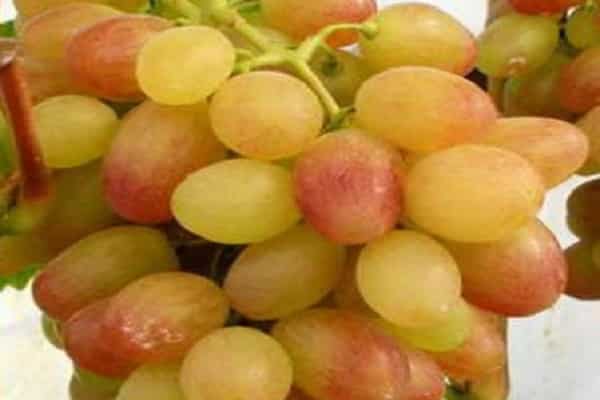
Pros and cons
Tason was the result of the selection of two grape varieties, so he took only the best qualities from his parents. The advantages of horticultural culture include:
- high productivity;
- short ripening period;
- ability to withstand mechanical stress during transportation;
- resistance to putrefactive phenomena, the ability to maintain taste and external qualities for a long time;
- long-term retention of bunches of grapes on the branches;
- the ability to tolerate low temperatures, high humidity and excessive precipitation.
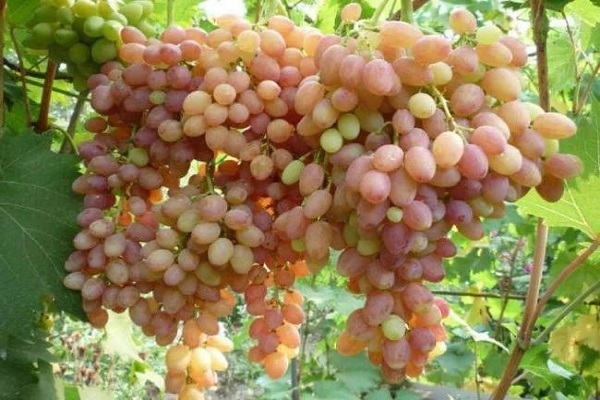
The main advantage of Tason grapes is the excellent taste of nutmeg berries, which were rated by experts as 8.2 points. The grape is recognized as one of the best representatives of the southern varieties. At the same time, gardeners note only 2 shortcomings of the culture - insufficient resistance to fungal diseases, the need for shelter in the winter.
Characteristics and description of appearance
Experts recognized the Tason grape as a striking representative of the muscat varieties, which is largely due to the excellent characteristics of the fruit. Its peculiarity lies in the fact that it is practically not used for the production of wines, as it is ideally suited for the purposes of implementation. It is one of the first to ripen, has a unique taste, easily tolerates long haulage and has a long shelf life.
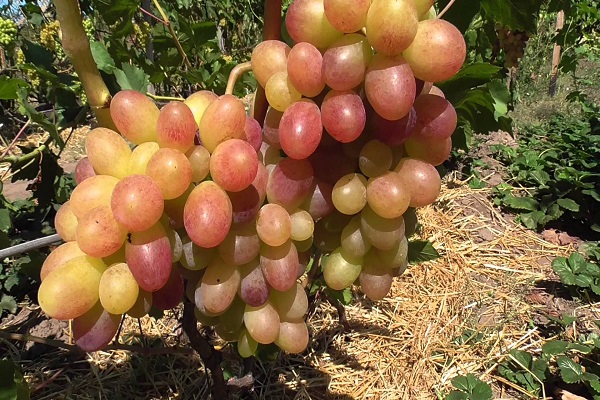
The plant belongs to frost-resistant, breeding qualities allow it to tolerate a decrease in temperature to -22 C, but in the northern regions, it is required to cover the shoots for the winter.
Bush
The grape bush has a strong growth. The leaf plates acquire a dark green color and are five-lobed in shape. The vine is distinguished by good ripening throughout the shoot. Reproduction of the culture by cuttings is acceptable.
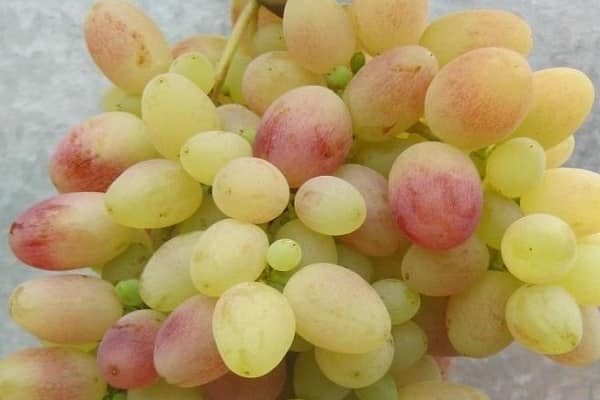
The amount of harvest and the taste of berries
The berries are collected in large clusters weighing from 500 to 800 g, some are capable of reaching a mass of 1200 g. With an amount of 30 to 40 shoots, 55% are fruiting. The fruits are characterized by a light white-pink color; when they are in the area of sunlight, they can acquire a slight tan. Characteristics of grapes:
- length - 25 cm;
- width - 18 mm;
- weight - 7 g.
Berries of the Tason variety have a dense skin and juicy pulp with a small content of small seeds. The taste is characterized by sweetness with a pronounced nutmeg undertone.

Tason planting technology
Getting a good harvest of grapes requires adherence to cultivation techniques. The key to getting a good return of berries is the correct choice of seedlings, compliance with planting requirements and care, taking into account the characteristics of the garden culture.
Selection of seedlings
It is recommended to purchase seedlings from a specialized nursery specializing in the cultivation of grape varieties. The optimal one is the one located in the same climatic zone. It is important to choose shoots with a well-developed root system, without damage, formations and signs of excessive dryness. During transportation, the roots are wrapped in foil to maintain a sufficient moisture level.
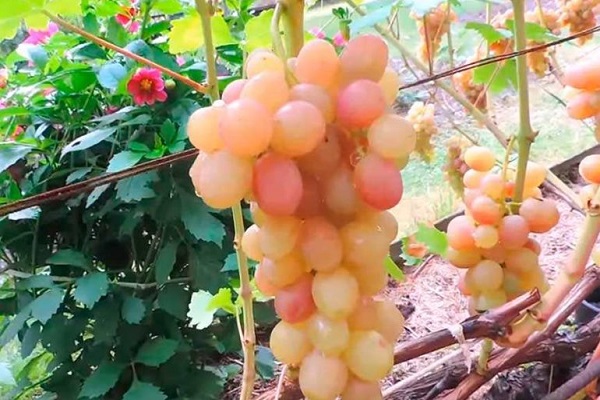
Timing
Planting is carried out in late March or early April. It is important that the shoots have time to root well, which will allow them to calmly overwinter and withstand low temperatures.
Planting scheme and depth
The soil for planting is prepared in the fall, carefully digging up. For planting, holes are formed 80 cm deep and 1 m wide.The distance between the bushes should be at least 1 m, 3 meters are left between the rows. At the bottom of each hole, compost, rotted manure and a complex of mineral fertilizers are placed. Immediately before planting, root pruning is carried out, removing 15 cm of the processes. For disinfection use a solution:
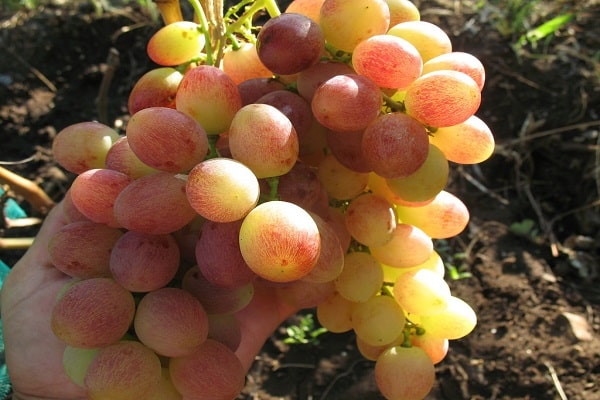
- "Hexachloran" - 200 g;
- clay - 400 g;
- water - 10 liters.
The roots are kept in the solution for 5 minutes, after which they are dipped into a "chatterbox" of clay and manure. If desired, I add a growth stimulator - "Fumar", sodium humate.
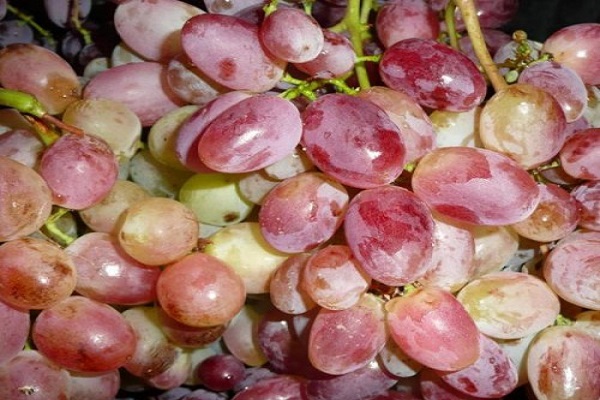
Growing conditions
The key to successful cultivation is knowledge of the characteristics of the variety and adherence to basic recommendations. It is important to choose the right planting site, timely prune and feed the plant.
Lighting
Grapes are heat-loving plants, so sunny, well-lit places are chosen for planting. The color of the berries will depend on the sufficiency of lighting. If it is deficient, they will be pale pink, and if normal, they will acquire a pleasant tan.
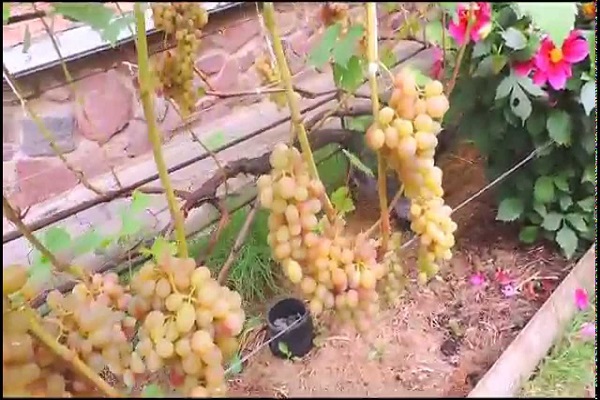
Demanding soil
The grapes need a light soil that has good moisture and air permeability. Heavy soils require work to improve permeability, for this they use broken brick, a mixture of small stones or coarse sand. Tason is demanding of the sufficient content of nutrients in the earth.
Watering
Tason loves abundant regular watering with warm water. Moisten the soil in the early morning hours or at sunset, when the plant is not exposed to direct sunlight. Liquid stagnation should not be allowed, as waterlogging negatively affects the health of the shoots.
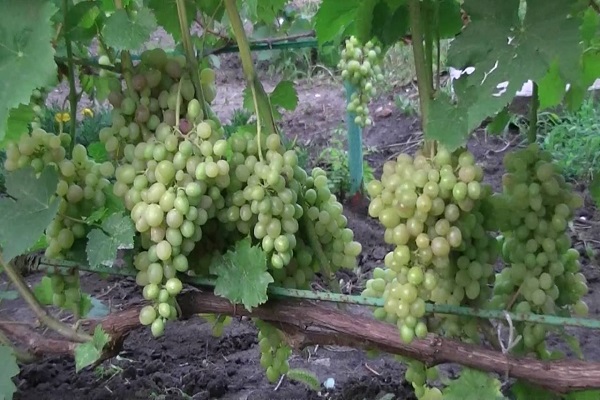
Fertilization and processing
Experts advise when fertilizing a plant to alternate fertilizing with organic matter and mineral fertilizers. Often for these purposes, gardeners use manure, compost, bird droppings. The choice of chemicals depends on the personal preference of the gardener.Depending on the growing season, the plant's nutritional requirements differ. It is worth adhering to the following recommendations:
- nitrogen fertilizers - contribute to the growth of green mass, therefore they are applied in the spring using urea or saltpeter, and in the autumn, such feeding will harm the plant;
- phosphorus is necessary for grapes during the flowering period, therefore, the introduction of superphosphate will contribute to the better formation and ripening of berries;
- potassium chloride - applied in the fall for accelerating the ripening of grapes and preparing the plant for winter;
- copper - accelerates plant growth;
- zinc - increases the yield of the crop.
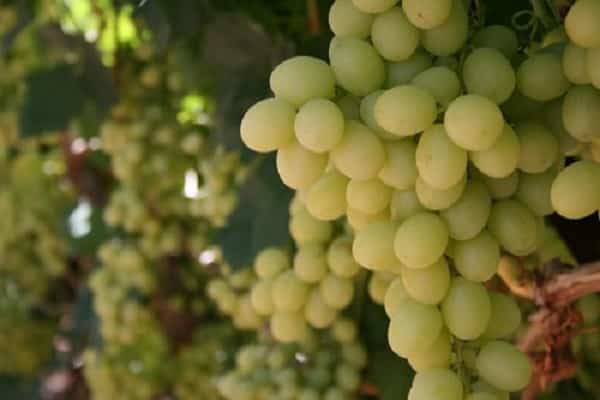
For fertilizing grapes, you can choose one - or multicomponent preparations. Among the popular means of complex action are Florovit, Aquarin, Kemira. Fertilization rates are calculated based on the recommendations of the instructions for the preparation.
Pruning
Pruning helps to increase yields, improve the taste of berries and increase their size. The procedure will help the fruit to ripen faster and reduce labor costs for plant care. Tason loves the sun, so the bushes are shaped so that each bunch gets enough sun. One bush should contain from 30 to 40 eyes and on one branch their number should not exceed 8.
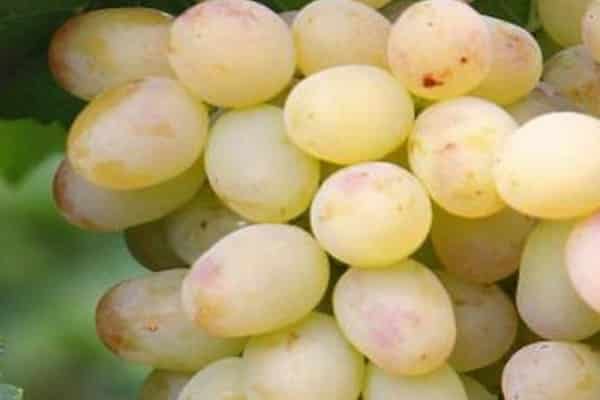
Shelter for the winter
Shelter for vine shoots is necessary when planting in a region with a cold climate. For these purposes, use any of the materials at hand - wood shields, slate, roofing material, linoleum. The plant is protected in the form of a triangle with a sharp top.
Pollination and the beginning of fruiting
The plant forms flowers of both sexes, so there is no need to plant other varieties on the site. Tason grapes are a representative of early ripening varieties, ripening period is 100-110 days. The first harvest in the southern regions begins to be taken in the second half of July. In cooler growing conditions, harvest time shifts up, but yields are not affected.
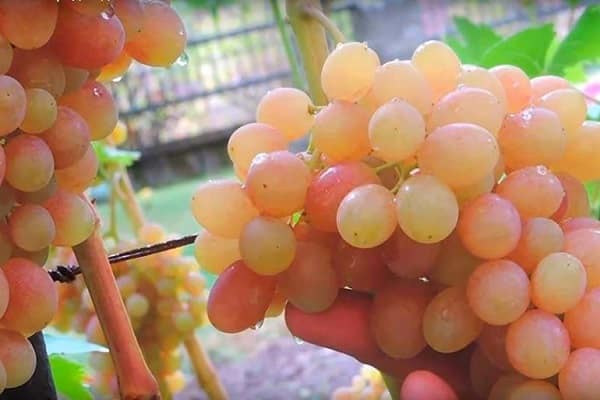
Harvesting and storage duration
The first bunches of grapes are removed in the second decade of July. If the harvest is abundant, they can be left on the shoots until mid-September. For fresh consumption, the berries are stored in the refrigerator, but not more than 30 days. When organizing special places in a cool room, the period can be extended up to 3 months. Tason is consumed not only fresh. Raisins are made from grapes, wine, juice, compote are prepared.
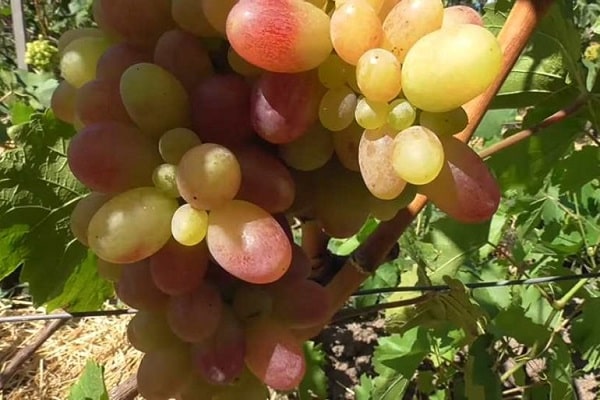
Diseases and pests. Measures to combat them
For grapes, the most dangerous disease is powdery mildew, in which the plant becomes covered with a whitish bloom. To combat it, use "Karbofos", "Folpet" and other drugs, which contain copper sulfate.
Aphid is the most dangerous of the pests. The insect feeds on the sap of the plant, which over time leads to a lack of nutrients. The appearance of curling leaves, blisters and swelling indicates the invasion of pests. To combat the invasion of aphids, targeted drugs are used.
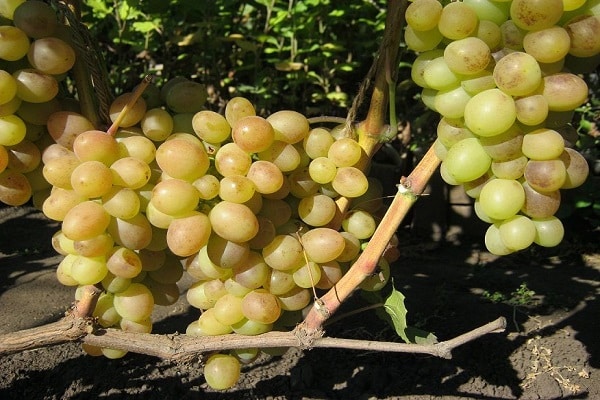
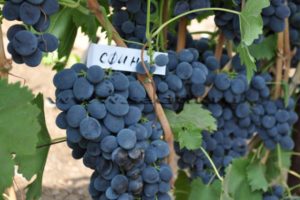
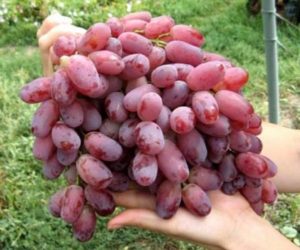




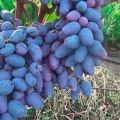
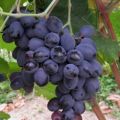
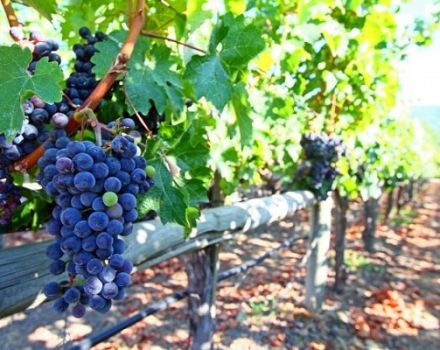
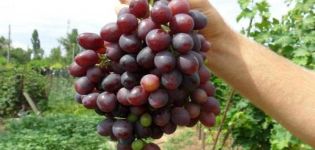
Typically, the average load per bush is 35 eyes. When growing this grape variety, it is necessary to normalize the bushes by inflorescences and remove underdeveloped shoots.This will contribute to better ventilation.
It is necessary to start with the choice of a variety, varieties with frost resistance of -20 C to -40 C are suitable for the Moscow region, and a ripening period of 80 to 140 days, for example Isabella 160-180 days is not suitable for the ripening period, although it is stubbornly sold to us, because without problems in the south, you can cut a lot of planting material and push it to us in the Moscow region, the seedling should preferably be from our climatic zone or long-term adaptation is guaranteed, plus the choice of a place and the correct planting, varieties must be chosen from early to late, we have the late ones We will not ripen for 140 days, over 150 days, it’s like we ate pear apples in the summer and in the fall we eat Antonovka, if we scatter the varieties according to the dates, the grapes will be from August to October.